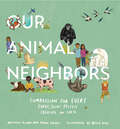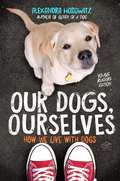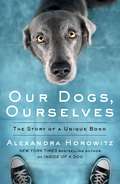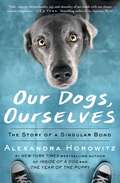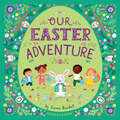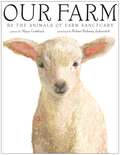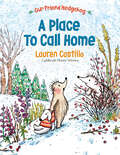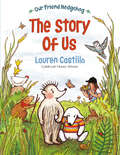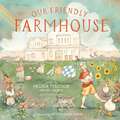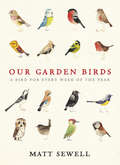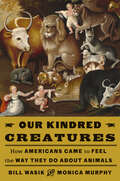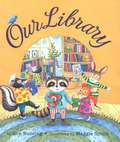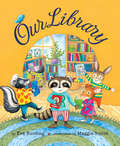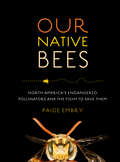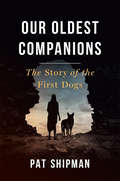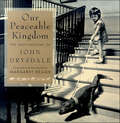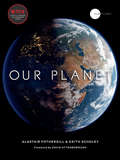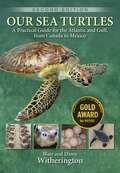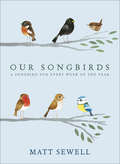- Table View
- List View
Our Animal Neighbors: Compassion for Every Furry, Slimy, Prickly Creature on Earth
by Matthieu Ricard Jason GruhlWinner of the Moonbeam Children's Animals/Pets Non-Fiction Gold Medal!A story about the fundamental connection between animals and people and how we can treat all of Earth's creatures with compassion and empathy.Furry polar bears, playful sea otters, slow sloths, prickly porcupines, and slimy snakes are just a few of the many animals we share our world with. And even though we might not look the same or have the same needs as our animal neighbors, we have more in common with them than we might think. Our Animal Neighbors introduces children to the importance of treating all animals with the care and compassion they deserve. We all want to experience love, safety, and respect and this book is the first step to instilling those values at an early age. This planet is our home, and we should all be free to live a prosperous life regardless of whether we have hands, hooves, scales, or fur.&“A serious message delivered with humor, simplicity, and charm makes this book an excellent purchase for families that value open-ended discussions. Also a good resource for classrooms and libraries that welcome diverse opinions and points of view.&”—School Library Journal
Our Cat Flossie
by Ruth BrownDescribes the pursuits Flossie loves best, such as gardening, helping make beds, collecting butterflies, getting in boxes, and sleeping.
Our Dogs, Ourselves -- Young Readers Edition: How We Live with Dogs
by Alexandra HorowitzThis middle grade adaptation of Our Dogs, Ourselves is an eye-opening, entertaining, and beautifully illustrated look about humans&’ complicated and sometimes contradictory relationship with man&’s best friend by New York Times bestselling author of Inside of a Dog—Young Readers Edition.We keep dogs and are kept by them. We love dogs and (we assume) we are loved by them. Even while we see ourselves in dogs, we also treat them in surprising ways. On the one hand, we let them into our beds, we give them meaningful names, make them members of our family, and buy them the best food, toys, accessories, clothes, and more. But we also shape our dogs into something they aren&’t meant to be. Purebreeding dogs has led to many unhealthy pups. Many dogs have no homes, or live out their life in shelters. How is it possible we can treat the same species in these two totally different ways? In Our Dogs, Ourselves Young Readers Edition, bestselling author of Inside of a Dog, Alexandra Horowitz reveals the odd, surprising, and contradictory ways we live with dogs.
Our Dogs, Ourselves: The Story Of A Singular Bond
by Alexandra HorowitzIn this book Alexandra Horowitz examines what's called the 'dog-human bond': examining all aspects of the complexity of this unique interspecies pairing. From her position as a dog scientist, she uses the science of dogs and dog-human interaction to ground a consideration of the various ways that dogs, as a species, reflect us, and how they reflect (sometimes badly, sometimes well) on us. And she goes beyond the cognitive science to consider the culture, laws, and human dynamics that reveal and restrict this bond between two disparate species. Horowitz shows that when each person makes the decision to breed, own, or adopt a dog, we enter into a relationship that will change us. It changes the course of our days: dogs need to be walked, fed, attended to. It can change the course of our lives: dogs weave their way into our lives with their constant silent presence by our sides. There are still many (often non-'scientific') questions that remain unanswered about dogs: about their minds, yes, but especially about living with dogs in our society, and how we can best treat them now and in the future. This books addresses those questions. It is intended for the curious dog owner and science-lover alike, who wants to read good, intelligent thinking on dogs, not overly sentimental but not without heart.
Our Dogs, Ourselves: The Story of a Singular Bond
by Alexandra HorowitzFrom the #1 New York Times bestselling author of Inside of a Dog and The Year of the Puppy, an eye-opening, informative, &“entertaining, and enlightening&” (BookPage) celebration of the human-canine relationship for the curious dog owner and science-lover alike.We keep dogs and are kept by them. We love dogs and (we assume) we are loved by them. We buy them sweaters, toys, shoes; we are concerned with their social lives, their food, and their health. The story of humans and dogs is thousands of years old but is far from understood. In Our Dogs, Ourselves, Alexandra Horowitz explores all aspects of this unique and complex relationship that &“dog lovers will savor and absorb&” (Shelf Awareness). As Horowitz considers the current culture of dogdom, she reveals the odd, surprising, and contradictory ways we live with dogs. We celebrate their individuality but breed them for sameness. Despite our deep emotional relationships with dogs, legally they are property to be bought, sold, abandoned, or euthanized as we wish. Even the way we speak to our dogs is at once perplexing and delightful. In thirteen thoughtful and charming chapters, Our Dogs, Ourselves affirms our profound affection for this most charismatic of animals—and makes us &“see canine companions in new ways&” (Science News).
Our Easter Adventure
by Emma RandallHop into an Easter adventure with this rhyming picture book that celebrates the magic of the holiday!Have you ever wondered where the Easter Bunny lives, or how he makes all those colorful eggs? Join a group of children as they follow a trail of eggs and discover his secret hideaway! The question is, what will they find there? Find out in Emma Randall's enchanting tale, complete with bright illustrations that encourage young ones to appreciate and enjoy the season.
Our Farm: By the Animals of Farm Sanctuary
by Maya GottfriedMaya the cow, J.D. the piglet, Hilda the sheep, and a dozen more animals all speak directly to the reader, showing off their unique personalities in this wonderful collection of poems. Master watercolorist Robert Rahway Zakanitch provides a portrait that perfectly captures the essence of each creature. Together the poems and paintings add up to a picture of life on the friendliest farm around.Maya Gottfried based her poems on real animals from Farm Sanctuary, a safe haven for injured or abused farm animals with locations in New York and California.
Our First Embrace
by Judy Lynn HubbardFrom first kiss to last Nicole Carter just landed her dream job working for fashion legend Alexander James in Paris. Sparks fly when they meet. But her buttoned-up alpha boss is determined to ignore the heat building between them, and Nicole knows crossing the line is taboo. Though that doesn't stop her from fantasizing about them sharing a steamy night together in the most romantic city in the world.... The once-burned-by-love designer doesn't trust women-or the powerful desire his alluring new hire is bringing to the forefront. Giving in to temptation will put everything Alexander's worked for at risk. Is he willing to fight for the woman he thinks he could spend forever with?
Our First Kiss
by Judy Lynn HubbardKiss by kiss, she's breaking down all his defenses... All Marcy Johnson ever wanted was to share her life with that special someone. And within the city's pool of eligible men, no one has yet proven himself to be the one for her. The New York stockbroker wonders if she's destined to remain forever single. Powerhouse D.C. attorney Nathan Carter just might change her mind. But Marcy's sexy, caring lover is definitely hiding something.... There's no room in Nathan's secret life for a complication like love. If Marcy knew that his law career was just a cover, she'd never trust him again. But the vibrant beauty refuses to give up on him-or their hot romance. When his latest Black Ops mission tears him from Marcy's arms, Nathan must choose between duty...and the woman whose kiss he desires above all others.
Our First Pony
by Marguerite HenryJoseph and Justin may be twins, but they sure aren't much alike. Besides looking different, they live in very different worlds. Joseph loves the outdoors, the sky and the land, and all the animals, Justin, on the other hand, would rather be indoors, playing his piccolo or reading a book. The only thing they have in common is Midge, a pinto Shetland pony. They give her all the love and attention any pony could ever ask for. And she ends up giving them more than they ever could have imagined -- a horse family of their own! With characteristic charm and simplicity, Marguerite Henry weaves a true-to-life tale about the joys and difficulties of owning and raising horses.
Our Friend Hedgehog: A Place to Call Home (Our Friend Hedgehog)
by Lauren CastilloFrom the Caldecott Honor-winning author of Our Friend Hedgehog: The Story of Us comes a warm-hearted story about the meaning of home and the power of friendship to help you become your truest self.Families come in all shapes and sizes. Sometimes they are joined by birth, and other times they are chosen...Autumn leaves are falling in Hedge Hollow, and the change in season brings with it a spiny surprise... another hedgehog! Is it friend or foe? Or is it . . . family? On the one paw, Hedgehog is excited to meet one of her own kind, but on the other paw, she has never felt so different—or distant—from her old friends. Where does Hedgehog belong, and who does she belong with? A journey upriver through an unfamiliar forest just might lead her home… From the award-winning author-illustrator of Our Friend Hedgehog: The Story of Us comes a tale of old friends and new, and the true meaning of home.
Our Friend Hedgehog: The Story of Us (Our Friend Hedgehog)
by Lauren CastilloFrom a Caldecott Honor-winning artist comes a cozy classic-in-the-making about finding your friends and sticking together through thick and thin. "Our Friend Hedgehog feels like a modern-day Winnie the Pooh. It's so warm and full of joy and love. It's got classic written all over it." --Victoria Jamieson, Newbery Honor-winning author of Roller GirlSometimes you make a friend, and it feels like you have known that friend your entire life. . . .Hedgehog lives on a teeny-tiny island with only her stuffed dog, Mutty, for company. When a great storm carries Mutty away, she embarks on a quest to find her friend. Following the trail of clues Mutty left behind, brave Hedgehog meets a wiggly Mole, a wordy Owl, a curmudgeonly Beaver, a scatterbrained Hen and Chicks, and a girl who's new to the neighborhood, Annika May. With bravery and teamwork, there's nothing that can stop these seven from finding Mutty, but along the way they discover something even more important: each other.The first book in a new series from Caldecott Honor winner Lauren Castillo, Our Friend Hedgehog: The Story of Us has the feel of a timeless classic, introducing an unforgettable cast of characters who will star in many more adventures to come.
Our Friendly Farmhouse
by Melissa FergusonBreathe in fresh, country air and dream of a slower, simpler, sweeter life in this poetic story about building a homestead with heart from bestselling novelist Melissa Ferguson.One day Papa burst into the kitchen with a wild idea. What if the family moved to the country? What if they built their very own farmhouse between sleeping strawberry fields and the misty Appalachian Mountains? Join a little boy and his adventurous parents and sisters as they chase a dream of open sky, nature to explore, a blooming garden, and lots of animal friends.This artful picture book for 4- to 8-year-olds …journeys alongside a family as they reach for the impossible and build their dream home in the country;follows the creation of a homestead, from digging the foundation and raising the walls to planting a garden, welcoming chicks and kittens, and snuggling a newborn baby on the porch;inspires families to dream together and set out on their own adventures; andfeatures a classic feel and a presentation page to make this book the perfect gift for anyone dreaming of country life, intentional living, and rewilding childhood.You&’re invited to Our Friendly Farmhouse, where children swing under the sunset after chasing a rainbow and snacking at a tea party, where ducklings and kittens keep you company, and where friends are always welcome. A place where there is time to wander, memories are made, and hearts are full.
Our Friendly Friends
by Louis SlobodkinDelightful verses of our relationships to the friendly animals children are most familiar with. For instance, it tells about after a party where Some eat a lot And some eat less, And some drink water, Others drink dew, Some drink milk Just like you. A good book for quiet time.
Our Garden Birds: a stunning illustrated guide to the birdlife of the British Isles
by Matt SewellIn this beautiful gift edition, pop-art street artist Matt Sewell offers his own unique take on 52 of our favourite British garden birds.'An offbeat book featuring 52 charming characterful illustrations of our best-loved British birds' -- BBC Wildlife'A treasure to behold' -- ***** Reader review'Quirky, creative but very well-observed' -- ***** Reader review'This book should be owned by all garden bird lovers!' -- ***** Reader review'Absolutely love this book!' -- ***** Reader review'Utterly charming!' -- ***** Reader review*************************************************************************************Since its first appearance in July 2009, Matt's 'Bird of the Week' feature for the Caught by the River website has quickly become a cult hit.His pop-art watercolours are distinctive and enchanting, as are his innovative descriptions, which see great tits 'bossing the other birds around', the 'playful yet shy buoyancy' of bullfinches and the 'improbable' nature of the waxwing ('like a computer-generated samurai finch').This witty, delightful and distinctive gift book will appeal to bird watching enthusiasts, children and adults, and art and illustration fans alike.
Our Kindred Creatures: How Americans Came to Feel the Way They Do About Animals
by Monica Murphy Bill WasikA compassionate, sweeping history of the transformation in American attitudes toward animals by the best-selling authors of RabidOver just a few decades at the end of the nineteenth century, the United States underwent a moral revolution on behalf of animals. Before the Civil War, animals' suffering had rarely been discussed; horses pulling carriages and carts were routinely beaten in public view, and dogs were pitted against each other for entertainment and gambling. But in 1866, a group of activists began a dramatic campaign to change the nation&’s laws and norms, and by the century&’s end, most Americans had adopted a very different way of thinking and feeling about the animals in their midst.In Our Kindred Creatures, Bill Wasik, editorial director of The New York Times Magazine, and veterinarian Monica Murphy offer a fascinating history of this crusade and the battles it sparked in American life. On the side of reform were such leaders as George Angell, the inspirational head of Massachusetts&’s animal-welfare society and the American publisher of the novel Black Beauty; Henry Bergh, founder of the American Society for the Prevention of Cruelty to Animals; Caroline White of Philadelphia, who fought against medical experiments that used live animals; and many more, including some of the nation&’s earliest veterinarians and conservationists. Caught in the movement&’s crosshairs were transformational figures in their own right: animal impresarios such as P. T. Barnum, industrial meat barons such as Philip D. Armour, and the nation&’s rising medical establishment, all of whom put forward their own, very different sets of modern norms about how animals should be treated.In recounting this remarkable period of moral transition—which, by the turn of the twentieth century, would give birth to the attitudes we hold toward animals today—Wasik and Murphy challenge us to consider the obligations we still have to all our kindred creatures.
Our Library
by Eve Bunting Maggie SmithWhen Miss Goose announces that the library is going to close forever, Raccoon and his friends spring into action. Where will they get the help they need to save their beloved library? In books, of course!This cheery tale from ever-popular author Eve Bunting shows how important libraries are to every community. Facing a dilemma that is all too common in our human world today, the adorable animal denizens of Buttercup Meadow confront it with an inspiring blend of ingenuity, teamwork, and imagination.Bright, playful illustrations enhance the light treatment of this serious subject, in a story that celebrates the value of books in everyone's lives.
Our Library
by Eve Bunting Maggie SmithWhen Miss Goose announces that the library is going to close forever, Raccoon and his friends spring into action. Where will they get the help they need to save their beloved library? In books, of course!This cheery tale from ever-popular author Eve Bunting shows how important libraries are to every community. Facing a dilemma that is all too common in our human world today, the adorable animal denizens of Buttercup Meadow confront it with an inspiring blend of ingenuity, teamwork, and imagination.Bright, playful illustrations enhance the light treatment of this serious subject, in a story that celebrates the value of books in everyone’s lives.
Our Native Bees: North America's Endangered Pollinators and the Fight to Save Them
by Paige Embry"Captures the essence of a bee’s natural history and how we use (and sometimes abuse) bees.” —Olivia Messinger Carril, author of The Bees in Your Backyard Honey bees get all the press, but the fascinating story of North America’s native bees—an endangered species essential to our ecosystems and food supplies—is just as crucial. Through interviews with farmers, gardeners, scientists, and bee experts, Our Native Bees explores the importance of native bees and focuses on why they play a key role in gardening and agriculture. The people and stories are compelling: Paige Embry goes on a bee hunt with the world expert on the likely extinct Franklin’s bumble bee, raises blue orchard bees in her refrigerator, and learns about an organization that turns the out-of-play areas in golf courses into pollinator habitats. Our Native Bees is a fascinating, must-read for fans of natural history and science and anyone curious about bees.
Our Oldest Companions: The Story of the First Dogs
by Pat ShipmanHow did the dog become man’s best friend? A celebrated anthropologist unearths the mysterious origins of the unique partnership that rewrote the history of both species. Dogs and humans have been inseparable for more than 40,000 years. The relationship has proved to be a pivotal development in our evolutionary history. The same is also true for our canine friends; our connection with them has had much to do with their essential nature and survival. How and why did humans and dogs find their futures together, and how have these close companions (literally) shaped each other? Award-winning anthropologist Pat Shipman finds answers in prehistory and the present day. In Our Oldest Companions, Shipman untangles the genetic and archaeological evidence of the first dogs. She follows the trail of the wolf-dog, neither prehistoric wolf nor modern dog, whose bones offer tantalizing clues about the earliest stages of domestication. She considers the enigma of the dingo, not quite domesticated yet not entirely wild, who has lived intimately with humans for thousands of years while actively resisting control or training. Shipman tells how scientists are shedding new light on the origins of the unique relationship between our two species, revealing how deep bonds formed between humans and canines as our guardians, playmates, shepherds, and hunters. Along the journey together, dogs have changed physically, behaviorally, and emotionally, as humans too have been transformed. Dogs’ labor dramatically expanded the range of human capability, altering our diets and habitats and contributing to our very survival. Shipman proves that we cannot understand our own history as a species without recognizing the central role that dogs have played in it.
Our Peaceable Kingdom: The Photographs of John Drysdale
by John DrysdaleA collection of gorgeous photographs depicting the loving bond between humans and various species of animals.John Drysdale's photographs are exciting, tender, hilarious, often exhilarating - but for more than the obvious reasons. Certainly it's not every day that one sees a lion that's befriended a Boston terrier. Maybe elephants don't usually go fishing, and parrots generally don't tend to lounge around in beach chairs, next to their human companions. But in the "peaceable kingdom" of John Drysdale, surprisingly unique alliances flourish. His photographs are whimsical and charming, but also carry a very important, necessary truth - the essential bonds of friendship transcend appearances, expectations, and traditions. Cats can love mice, bulldogs can rear squirrels, and foxes can protect chicks.With a refreshingly honest eye, Drysdale has captured the many ways in which the creatures that inhabit the earth bring one another comfort and happiness. Never mind that a burro and a boy are curled up on the sofa, or that a chimpanzee is sunbathing with his human family by the pool. Friendship is where you find it. The familiarity and love expressed in Drysdale's work is heartfelt and very real - as the endnotes explain, the exotic animals that are his subjects were often orphaned as babies, and reared along with the humans and other animals in the photographs.Since his earliest photographs of children frolicking on the cobblestoned streets of London, Drysdale's wonderfully illustrious career has spanned close to fifty years. And in Our Peaceable Kingdom, for the first time, 100 of his most memorable images are collected in one beautiful volume, destined to become a favorite on the shelves of children, adults, animal lovers, and anyone who appreciates a good friend.
Our Planet: And Our Planet's Surprising Future
by Fred Pearce Alastair Fothergill Keith ScholeyWith a foreword by Sir David Attenborough, this is the striking photographic companion to the groundbreaking NETFLIX original documentary series, presenting never-before-seen visuals of nature's most intriguing animals in action and the environmental change that has to be seen to be believed.With six hundred members of crew filming in fifty countries over four years, the directors that brought us the original Planet Earth and Blue Planet now take readers on a journey across all the globe’s different biological realms to present stunning visuals of nature's most intriguing animals in action, and environmental change on a scale that must be seen to be believed. Featuring some of the world's rarest creatures and previously unseen parts of the Earth―from deep oceans to remote forests to ice caps―Our Planet takes nature-lovers deep into the science of our natural world. Revealing the most amazing sights on Earth in unprecedented ways, alongside stories of the ways humans are affecting the world’s ecosystems―from the wildebeest migrations in Africa to the penguin colonies of Antarctica―this book places itself at the forefront of a global conversation as we work together to protect and preserve our planet. With a keepsake package featuring debossing and foil stamping, this groundbreaking coffee-table book reveals the most amazing sights on Earth in unprecedented ways.
Our Sea Turtles: A Practical Guide for the Atlantic and Gulf, from Canada to Mexico
by Blair Witherington Dawn WitheringtonOur Sea Turtles is the story of understanding, experiencing, and saving the sea turtle and helping them thrive in our oceans. Now in its second edition, Blair and Dawn Witherington&’s iconic book includes updated facts and figures, new photos, and new calls to action for saving the turtles. Well-organized sections that are full of photos, maps, and figures help readers get a sense of the various types of sea turtles and how they might be similar or different from one another. Those who are interested in not only learning about the marine animal but also in helping it benefit from the authors&’ precise knowledge and understanding of sea turtles.
Our Songbirds: A songbird for every week of the year
by Matt SewellIn this beautiful follow-up to 2012's hit, Our Garden Birds, street artist Matt Sewell offers more watercolours and quirky descriptions of British songbirds.In Matt's world, the peewit sings the blues, and the bittern fills his neck 'like a tweed pair of bellows'. Distinctive and enchanting, with a songbird for each week of the year, this delightful gift book will appeal to birders, children and adults, and art and design fans alike.
Our Superhero Chickens (Into Reading, Level O #33)
by James Hart Marg McAlisterNIMAC-sourced textbook
